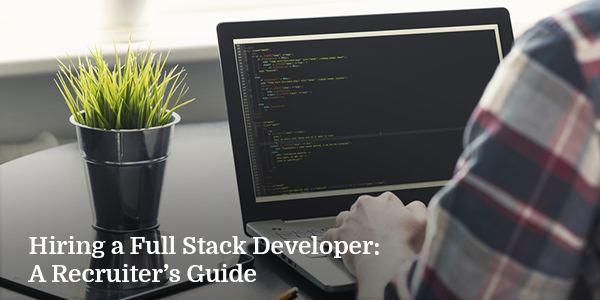Hiring full stack developers is like finding a needle in a haystack; it’s a tough challenge. Not every developer is adept in both front end and back end of web development. That’s why recruitment firms or hiring managers should be extra careful in examining their pool of candidates.
Front end refers to how a web page is laid out—from the positioning of text to the animation of images to buttons and their colors, or the user interface, in short. On the other hand, back end directs the front end to communicate with the cloud, where all information is stored and mobilized to make the website perform specific functions or in short, the programming side.
With so many things going on the front and back end, it’s not always easy for a single person to be an expert in both those areas. So, to be sure that you’re hiring the best full stack developers in the technical field, here are things you should be looking at.
What a Full Stack Developer Does
The responsibilities of a full stack developer have several layers you need to understand. Check out these layers, along with the required skills and tools, your candidate needs to know:
1) Server, Network, and Hosting Environment
This layer is concerned with system administration or the proper use of website resources, including file system, cloud storage, and network resources, among others. The full stack developer is expected to know which of these could break, and what could cause the breakdown.
Full stack developers need to have technical skills related to:
- Linux and basic shell scripting. This refers to the operating system developers use to build a website.
- Cloud computing. Your candidate should know how to manage servers through cloud hosting with service providers that include Amazon, Rackspace, and several others.
- Background processing. This part requires developers to work with queuing systems like Gearman and Redis to take care of job queues and message queues.
- Search. Your candidate should able to set up search servers such as Elasticsearch, Sphinx, and Solr’ to integrate search functions on the website.
- Caching. Your candidate should know how to use systems like Varnish, Memcached, APC / OpCache to cache tons of data so that any application request to the server can load faster.
- Monitoring. Your candidate will be in charge in monitoring IT systems, networks, and infrastructure with such applications as Nagios.
- Web servers. Your candidate needs to be familiar as to how open source servers like Apache and Nginx work to complete a web stack.
2) Data Modeling
Techopedia defines data modeling as “a representation of the data structures in a table for a company’s database and [… is] the guide used by functional and technical analysts in the design and implementation of a database.”
The full stack developer needs to display efficiency in saving data received from the front end by being familiar with database management systems such as MySQL, MongoDB, Cassandra, Redis, or SQL / JSON.
3) Business Logic
Apart from technical skills, the full stack developer must be able to assess if the application is providing real value to the business.
4) Back-end / API layer / Action Layer / MVC
In this layer, the full stack developer needs to know how to separate the application’s logic from the display which renders codes to become machine-readable.
The technical skills involved here are those pertaining to a programming language, and the most common of which include PHP, NodeJS, and Ruby.
5) User Interface
As far as user interface is concerned, the full stack developer has to understand what it takes to create a readable layout using the most ideal programming language, frameworks, and methodologies (see list of technical skills below). It might be necessary for the developer to tap the services of graphic design artists to take care of the visual aesthetics of the website.
The following technical skills are required for this:
- HTML / HTML5: Semantic web
- CSS / CSS3: LESS, SASS, Media Queries
- JavaScript: jQuery, AngularJS, Knockout, etc.
- Compatibility quirks across browsers
- Responsive design
- AJAX, JSON, XML, WebSocket
6) User Experience
The full stack developer needs to make sure that the whole user experience is pleasant for website visitors through a simplified process of finding what they need with minimal clicks.
7) Understanding What the Customer and the Business Need
At the end of the day, the full stack developer has to recognize whether or not the applications in use are responsive to the needs of the end user, and at the same time, are giving value to the business.
In sum, your ideal full stack developer should know everything about web development—whether front end or back end programming. He/she must be creative enough to plan the visual and aesthetic side of web development, and is an effective communicator to the team.
WE LEAD INNOVATION IN HEADHUNTING
SPECIALIST RECRUITMENT SOLUTIONS DELIVERING UNRIVALLED RESULTS
IN THE PHILIPPINES
Manila Recruitment is recognized as the leading recruitment firm in the Philippines for headhunting, executive search, expert, technical and IT recruitment. We share an unrivalled passion to help your business succeed by understanding your goals, then sourcing and providing you with your number one asset – driven, dedicated and exceptional people!
Experience the Manila Recruitment difference, and give your business in the Philippines a competitive advantage by contacting us today. Whether you are exploring an offshore solution, or are an established entrepreneur, SME or Multinational in the Philippines, our team has the experience and a tailored recruitment solution to introduce you to the top talent in the Philippines.
Contact our Manila Recruitment team at hello@manilarecruitment.com.















